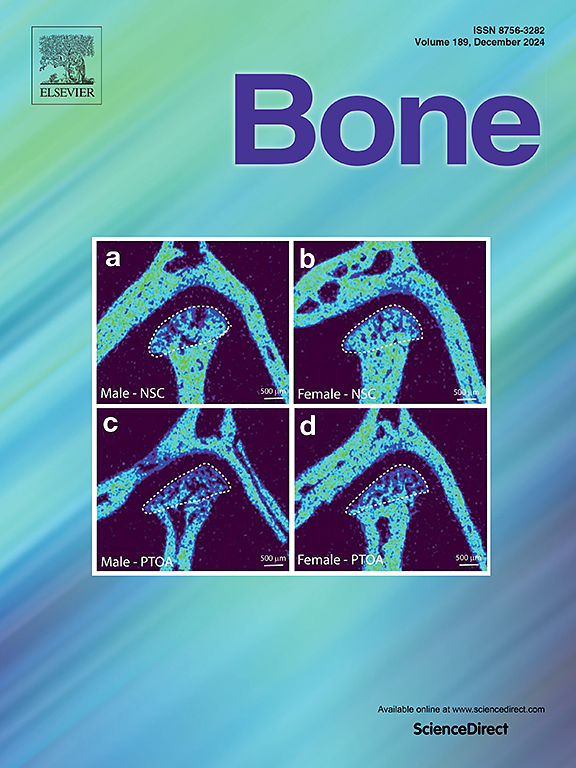单侧髋关节骨关节炎患者髋部骨密度的侧对侧差异
IF 3.6
2区 医学
Q2 ENDOCRINOLOGY & METABOLISM
引用次数: 0
摘要
背景:准确评估单侧髋关节骨关节炎(OA)患者的骨密度(BMD)对于诊断骨质疏松和选择髋关节置换术植入物至关重要。我们的目标是测量两侧骨密度的差异,检查影响因素,并确定这些患者骨密度评估的最佳一侧。方法对108例单侧髋关节骨关节炎患者进行分析。采用经过验证的深度学习方法,通过定量CT (QCT)自动评估双侧髋关节骨密度。我们评估了OA和健康髋关节在整个、颈部和远端区域的骨密度差异。为了确定他们的贡献,我们分析了包括患者人口统计学、Crowe分类、Bombelli分类、膝关节OA状态、髋关节功能评分和臀肌体积和密度在内的因素。此外,我们使用基于QCT的t评分检查了两侧骨密度差异如何影响骨质疏松症的诊断。结果OA侧的平均骨密度比健康侧低6.9%,颈部高14.5%,远端低9.4%。导致骨密度降低的因素包括年轻、Bombelli分型(萎缩型)和显著的臀肌萎缩。OA侧诊断的敏感性(61%)低于健康侧(88%)。结论单侧分析能更准确地从健康侧诊断骨质疏松。尽管如此,双侧骨密度评估仍然至关重要,特别是在年轻人和萎缩性骨性关节炎患者中。虽然基于QCT,我们的研究结果支持双能x线吸收仪对这些患者的双侧分析。本文章由计算机程序翻译,如有差异,请以英文原文为准。
Side-to-side differences in hip bone mineral density in patients with unilateral hip osteoarthritis
Background
Accurately evaluating bone mineral density (BMD) in patients with unilateral hip osteoarthritis (OA) is crucial for diagnosing osteoporosis and selecting implants for hip arthroplasty. Our goal was to measure the BMD differences between sides, examine contributing factors, and identify the optimal side for BMD assessment in these patients.
Methods
We analyzed 108 women with unilateral hip OA. Bilateral hip BMD was assessed automatically through quantitative CT (QCT) utilizing a validated, deep-learning-based approach. We evaluated BMD variations between the OA and healthy hips across total, neck, and distal regions. To determine their contributions, we analyzed factors, including patient demographics, Crowe classification, Bombelli classification, knee OA status, hip functional score, and gluteal muscle volume and density. Furthermore, we examined how side-to-side BMD differences influenced osteoporosis diagnosis using T-scores based on QCT.
Results
The average BMD on the OA side was 6.9 % lower in the total region, 14.5 % higher in the neck region, and 9.4 % lower in the distal region than on the healthy side. Contributing factors to the reduced BMD in the OA hip included younger age, Bombelli classification (atrophic type), and significant gluteal muscle atrophy. Diagnoses from the OA side revealed lower sensitivity (61 %) than those from the healthy side (88 %).
Conclusions
Analysis on one side alone yields a more precise osteoporosis diagnosis from the healthy side. Nonetheless, bilateral BMD assessment remains crucial, particularly in younger individuals and those with atrophic OA types. Although based on QCT, our findings support bilateral analysis by dual-energy X-ray absorptiometry for these patients.
求助全文
通过发布文献求助,成功后即可免费获取论文全文。
去求助
来源期刊

Bone
医学-内分泌学与代谢
CiteScore
8.90
自引率
4.90%
发文量
264
审稿时长
30 days
期刊介绍:
BONE is an interdisciplinary forum for the rapid publication of original articles and reviews on basic, translational, and clinical aspects of bone and mineral metabolism. The Journal also encourages submissions related to interactions of bone with other organ systems, including cartilage, endocrine, muscle, fat, neural, vascular, gastrointestinal, hematopoietic, and immune systems. Particular attention is placed on the application of experimental studies to clinical practice.
 求助内容:
求助内容: 应助结果提醒方式:
应助结果提醒方式:


